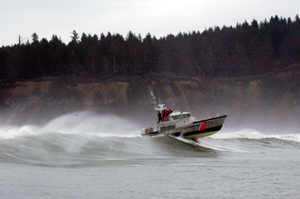





 On the night of February 12, 1997, the crew aboard a 31-foot sailboat, the Gale Runner, became trapped during a violent storm in the waters off the rugged and often dangerous Pacific Northwest coast near La Push, Wash. The master attempted to escape the fury of the storm by sailing to a nearby marina, but that attempt was thwarted when 25-foot waves and 30-knot winds demasted the boat and blew out hatches and portholes.
On the night of February 12, 1997, the crew aboard a 31-foot sailboat, the Gale Runner, became trapped during a violent storm in the waters off the rugged and often dangerous Pacific Northwest coast near La Push, Wash. The master attempted to escape the fury of the storm by sailing to a nearby marina, but that attempt was thwarted when 25-foot waves and 30-knot winds demasted the boat and blew out hatches and portholes. Lost in the accident were Petty Officer Second Class David Bosely, Petty Officer Third Class Matthew Schlimme and Seaman Clinton Miniken.
Lost in the accident were Petty Officer Second Class David Bosely, Petty Officer Third Class Matthew Schlimme and Seaman Clinton Miniken. As a result, surfmen transferred to cutters could not practice their trade and eventually lost their certifications. Their replacements at the stations required years of training to qualify creating a shortage of surfmen, as was the case at Station Quillayute River in 1997.
As a result, surfmen transferred to cutters could not practice their trade and eventually lost their certifications. Their replacements at the stations required years of training to qualify creating a shortage of surfmen, as was the case at Station Quillayute River in 1997. "Anytime we go into the surf, we have a briefing and agree on our limitations" said Chief Warrant Officer Rick Spencer, Commanding Officer of the National Motor Lifeboat School. "Our number one priority is safety."
"Anytime we go into the surf, we have a briefing and agree on our limitations" said Chief Warrant Officer Rick Spencer, Commanding Officer of the National Motor Lifeboat School. "Our number one priority is safety." The Coast Guard has taken many steps to make rescue operations in the small boat community as safe as possible - but it will never be possible to completely eliminate the risks associated with performing rescues and training in rough seas.
The Coast Guard has taken many steps to make rescue operations in the small boat community as safe as possible - but it will never be possible to completely eliminate the risks associated with performing rescues and training in rough seas.